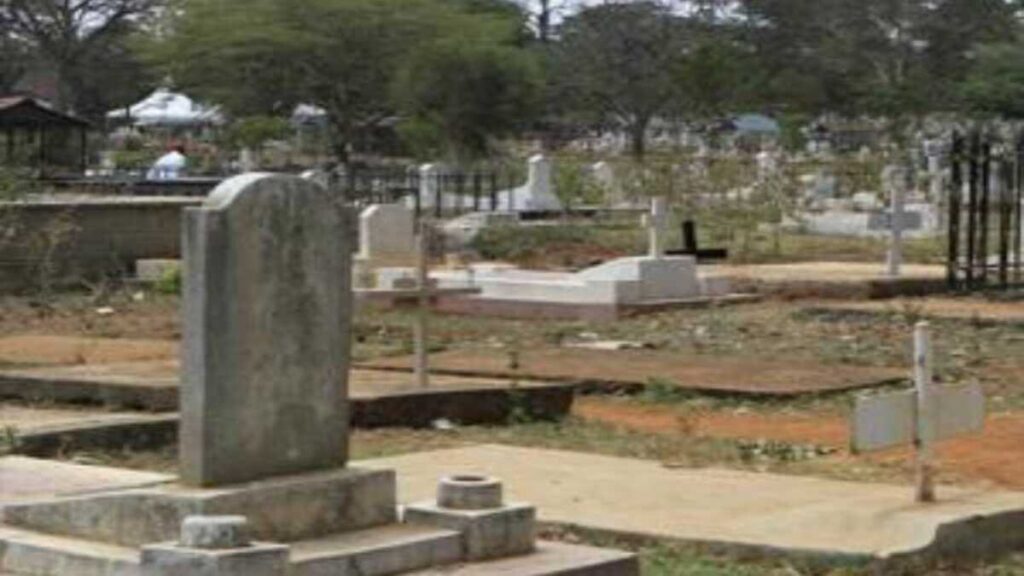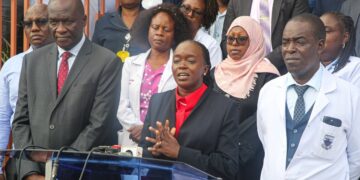In a chilling development, detectives have established a connection between a mutilated body discovered at Lang’ata Cemetery and the ongoing investigation into the brutal murders of three family members in Eastleigh. The body, which was found on October 31, has been tentatively identified as that of Hashim Dagane Muhumed, the prime suspect in the horrific killings that have sent shockwaves through the community.

Investigators at the crime scene around Lang’ata Cemetery, examining evidence related to the gruesome discovery of human remains.
The tragic case began to unfold when the bodies of Dahabo Daud Said, Amina Abdirashid Dahir, and Nusayba Abdi Mohammed were found in their home in Eastleigh. The family members were reported missing for several days before their remains were discovered, leading to widespread fear and outrage among residents. The murders were characterised by extreme violence, with investigators noting signs of a struggle and evidence suggesting a premeditated attack.

“The entrance to Lang’ata Cemetery, where a mutilated body was discovered, raising concerns over rising violence in Nairobi.”
As the investigation progressed, attention turned to Muhumed, who had been living in the same vicinity as the victims. Eyewitness accounts and forensic evidence began to paint a troubling picture of his involvement. Authorities described him as a person of interest, but he remained elusive, prompting a manhunt that captured the public’s attention.
The discovery of the mutilated body at Lang’ata Cemetery added another layer of complexity to the investigation. Initially, authorities were alerted to the scene by local residents who reported a foul smell emanating from the area. Upon arrival, detectives were confronted with a gruesome sight that confirmed their worst fears: the body showed signs of severe mutilation and appeared to have been discarded hastily.
Forensic experts quickly moved in to gather evidence from the scene. They noted that the condition of the body suggested it had been there for some time, raising questions about its identity and how it might relate to the ongoing murder investigation in Eastleigh. As detectives worked diligently to piece together the circumstances surrounding this latest discovery, they began to explore potential links between Muhumed and both crime scenes.
As investigators delved deeper into Muhumed’s background, they uncovered a troubling history marked by violence and erratic behaviour. Neighbours described him as a troubled individual who often exhibited aggressive tendencies. Reports also indicated that he had been involved in previous altercations within the community, raising concerns about his mental state and potential propensity for violence.
In light of these findings, detectives sought to establish a timeline of events leading up to both the Eastleigh murders and the discovery at Lang’ata Cemetery. They interviewed witnesses and gathered surveillance footage from nearby areas in an effort to track Muhumed’s movements. This meticulous approach aimed not only to confirm his involvement but also to prevent any further acts of violence.
The string of violent incidents has left residents in Eastleigh feeling vulnerable and anxious. Community leaders have called for increased police presence in the area, urging authorities to take decisive action against rising crime rates. Many residents expressed their fears during community meetings, highlighting the need for safety measures and support for families affected by violence.
Local organisations have also stepped up efforts to provide counselling and support services for those impacted by these tragic events. The community has rallied together, holding vigils and memorials for the victims while demanding justice for their untimely deaths.
As detectives continue their investigation into both cases, they remain committed to uncovering the truth behind these heinous acts. The link between Muhumed and the mutilated body found at Lang’ata Cemetery has raised pressing questions about his motives and whether he acted alone or had accomplices.
Authorities have urged anyone with information related to either case to come forward, emphasising that even small details could prove crucial in piecing together this disturbing puzzle. As fear lingers in Eastleigh and beyond, there is hope that justice will prevail and that communities can begin to heal from these traumatic events.
The connection between the mutilated body found at Lang’ata Cemetery and the Eastleigh murders underscores a troubling trend of violence that has gripped parts of Nairobi. As investigators work tirelessly to bring those responsible to justice, it is imperative for communities to unite against such acts of brutality. The road ahead may be fraught with challenges, but with determination and collaboration, there is hope for healing and restoration in affected areas.



















